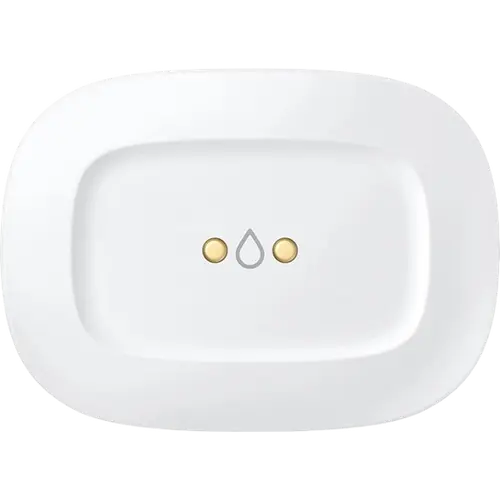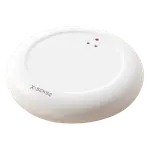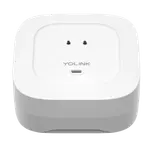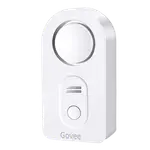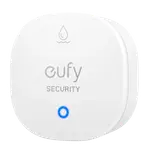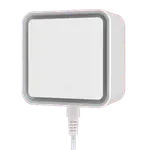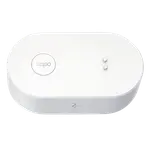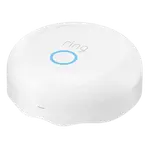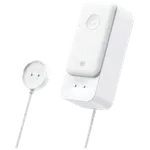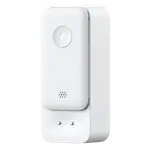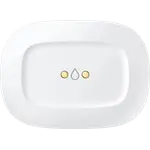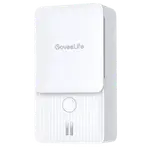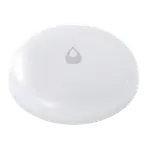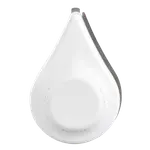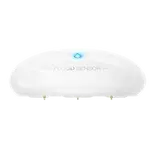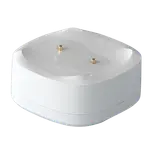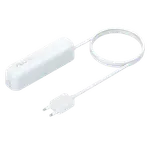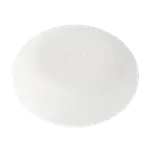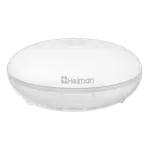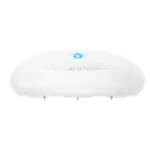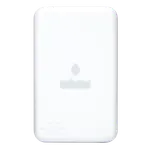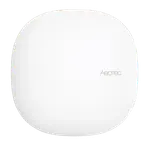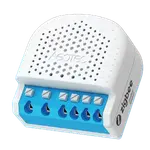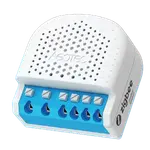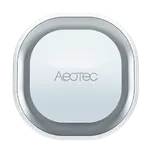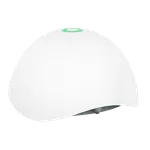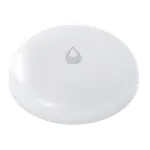Summary
Size & Materials: 47g / 1.76oz, 60 x 36 x 24 mm
Power: Wired (NO)
Connectivity: Zigbee (Zigbee Hub required)
Integrations: Samsung SmartThings, Home Assistant
Sensors: Water Leak, Temperature
Alerts: Water Leak Alerts, Temperature Alerts, Freeze Temperature Alerts
Price History
| Brand | Aeotec |
|---|---|
| Headquarters | |
| Website | https://aeotec.com |
| @Aeotec_Official |
Size & Materials
Devices are typically rated using the Ingress Protection (IP) scale, which indicates the level of protection against dust, solid particles, and moisture.
An IP rating (Ingress Protection rating) is a standardized way to describe how well a device is protected against solids (like dust) and liquids (like water). The rating consists of two digits:
- The first digit represents protection against solid particles (e.g., dust).
- The second digit represents protection against liquids (e.g., water).
First Digit (Protection Against Solids):
- IP0X: No protection against solid objects.
- IP1X: Protection against solid objects larger than 50 mm (e.g., accidental touch by hand).
- IP2X: Protection against objects larger than 12.5 mm (e.g., fingers).
- IP3X: Protection against objects larger than 2.5 mm (e.g., tools or thick wires).
- IP4X: Protection against objects larger than 1 mm (e.g., thin wires or small tools).
- IP5X: Dust-protected. Limited ingress of dust is allowed, but it won't interfere with operation.
- IP6X: Dust-tight. Complete protection against dust, ensuring no ingress of particles.
Second Digit (Protection Against Liquids)
- IPX0: No protection against water.
- IPX1: Protection against vertically falling water droplets (e.g., light rain).
- IPX2: Protection against vertically dripping water when tilted up to 15°.
- IPX3: Protection against water sprayed at an angle of up to 60° (e.g., light splashing).
- IPX4: Protection against water splashes from any direction.
- IPX5: Protection against water jets from any direction (e.g., a garden hose).
- IPX6: Protection against powerful water jets (e.g., heavy rain or washing with a hose).
- IPX7: Protection against temporary immersion in water up to 1 meter deep for up to 30 minutes.
- IPX8: Protection against continuous immersion in water beyond 1 meter.
IP20
Length x Width x Height
- Length: the longest side of the device
- Width: the shorter side of the device
- Height: the vertical dimension of the device
60 x 36 x 24 mm
The physical weight of the device, typically measured in grams (g) or ounces (oz).
Weight can be important for installation considerations, especially for wall-mounted or battery-powered devices.
47g / 1.76oz
Included accessories
A cable included with the device for connecting the sensor to the main unit.
NO
Power
Powered by direct electrical connection to your home's power supply.
Wired power ensures continuous operation without battery maintenance or replacement concerns.
NO
Battery-powered sensors typically use standard batteries like AA, AAA, or button-cell batteries (CR2032, CR123A), which are easy to replace and widely available.
CR2
Sensors that connect via Wi-Fi tend to consume more power due to the constant need to maintain a connection with the network, meaning more frequent battery replacements.
Zigbee, Z-Wave, and Thread Sensors are designed for low-power devices, allowing sensors to last much longer on battery power, often up to 3-5 years before needing a battery change.
Bluetooth Low Energy (BLE) sensors have moderate power consumption, offering a reasonable battery life depending on usage.
1 year
Connectivity
Range: The 2.4 GHz band offers a longer range, meaning it can cover larger areas and penetrate solid objects like walls more effectively than 5 GHz.
Speed: Generally, 2.4 GHz provides slower speeds compared to 5 GHz due to a lower maximum data rate.
Interference: More prone to interference since many other devices (like cordless phones, microwaves, and Bluetooth devices) operate on the 2.4 GHz frequency, leading to potential congestion and slower network performance.
NO
Range: Offers a shorter range compared to 2.4 GHz and may have difficulty penetrating walls and other obstacles.
Speed: Typically provides faster speeds and higher data rates due to more available bandwidth.
Interference: Less prone to interference as fewer devices operate on this frequency, leading to a more stable connection.
NO
Bluetooth is a wireless communication technology used for exchanging data over short distances.
Bluetooth enables devices to communicate wirelessly within a short range, typically up to 10 meters (about 33 feet) for most consumer devices.
NO
Zigbee is a wireless communication protocol designed for low-power, short-range applications, commonly used in smart home devices, industrial automation, and other areas requiring reliable, low-data rate communication. It features low power consumption, making it ideal for battery-operated devices, and supports short-range communication, typically up to 100 meters. Zigbee employs mesh networking, allowing devices to relay data through each other to extend range and improve reliability. It supports data rates up to 250 kbps, suitable for small data packets, and ensures interoperability among devices from different manufacturers if they conform to Zigbee standards. Security is robust, with AES-128 encryption for data protection.
Z-Wave is known for its low power consumption, making it ideal for battery-powered devices. It supports a mesh networking topology, allowing devices to communicate with each other directly or through intermediary nodes, thus extending the overall network range and enhancing reliability. The protocol supports data rates of up to 100 kbps, suitable for transmitting control commands and sensor data.
NO
Zigbee is a wireless communication protocol designed for low-power, short-range applications, commonly used in smart home devices, industrial automation, and other areas requiring reliable, low-data rate communication. It features low power consumption, making it ideal for battery-operated devices, and supports short-range communication, typically up to 100 meters. Zigbee employs mesh networking, allowing devices to relay data through each other to extend range and improve reliability. It supports data rates up to 250 kbps, suitable for small data packets, and ensures interoperability among devices from different manufacturers if they conform to Zigbee standards. Security is robust, with AES-128 encryption for data protection.
Zigbee devices need a Zigbee-compatible hub to connect and communicate with other devices in your smart home setup.
Zigbee Hub required
Thread is a wireless communication protocol designed specifically for Internet of Things (IoT) devices, providing secure, reliable, and scalable networking. Unlike some other protocols, Thread is IP-based, which means it can seamlessly integrate with existing internet infrastructure. It operates in the 2.4 GHz frequency band and uses mesh networking to enhance reliability and extend range by allowing devices to relay data through each other.
Thread is optimized for low power consumption, making it suitable for battery-operated devices. It supports low-latency communication, which is crucial for real-time applications like home automation and security systems. The protocol ensures high security with AES-128 encryption and end-to-end security at the network layer. Thread also supports over-the-air updates, ensuring devices can stay up to date with the latest features and security patches.
Thread-enabled devices require a Thread Border Router (such as certain smart home hubs or routers) to connect to your home network and other Thread devices.
NO
Additional connectivity options not covered by the standard protocols.
This may include proprietary wireless protocols, infrared, or other specialized communication methods.
NO
Integrations
Google Home serves as a central hub for a variety of smart devices, including lights, thermostats, cameras, and speakers. It leverages Google Assistant for voice control, enabling users to manage their smart home with simple commands.
NO
Amazon Alexa is one of the most widely used smart home systems, known for its compatibility with a vast array of devices. Users can control everything from smart lights to appliances using voice commands through Echo devices.
NO
Apple HomeKit is designed for users in the Apple ecosystem, providing a seamless way to control compatible smart devices through iOS devices using the Home app or Siri. It emphasizes security and user privacy.
NO
SmartThings is a flexible platform that connects a wide range of devices from different brands, offering a unified interface for control. It supports various communication protocols, allowing for extensive device compatibility.
YES
Home Assistant is an open-source platform that allows for extensive customization and integration of a wide variety of smart devices. It supports a multitude of protocols and brands, making it ideal for tech-savvy users.
YES
IFTTT (If This Then That) is a web-based service that allows users to create simple automation sequences, known as applets, which enable different devices, services, and applications to work together seamlessly. It connects a wide range of products and services, facilitating interoperability and enhancing functionality.
NO
Matter is a unified, open-source connectivity protocol designed to standardize and simplify communication between smart home devices from different manufacturers. Developed by the Connectivity Standards Alliance (formerly the Zigbee Alliance), Matter aims to improve interoperability, security, and reliability across various smart home ecosystems.
Matter operates over existing networking technologies, including Ethernet, Wi-Fi, and Thread, providing flexibility in device connectivity. Its IP-based nature allows seamless integration with existing internet infrastructure and cloud services. Matter uses a mesh networking topology, particularly when operating over Thread, to enhance range and reliability by allowing devices to relay data through each other.
Security is a cornerstone of Matter, with end-to-end encryption and secure device onboarding processes ensuring robust protection for data and privacy. Matter also supports over-the-air updates, allowing devices to stay current with the latest features and security enhancements.
NO
Sensors
Detection of water presence where it shouldn't be.
Water leak detection provides early warning of plumbing failures, appliance leaks, or flooding.
YES
Built-in temperature sensor for monitoring ambient conditions.
Temperature monitoring can help detect environmental changes that might affect water systems or indicate potential problems.
YES
Detection of changes in orientation or angle.
Tilt detection can alert you when objects are moved or when doors/windows are opened.
NO
Alerts
Immediate notifications when water is detected.
Water leak alerts allow quick response to prevent extensive water damage and costly repairs.
YES
Notifications when temperature readings exceed or fall below preset thresholds.
Temperature alerts can help prevent damage to sensitive items and ensure comfortable living conditions.
YES
Notifications when temperatures drop to levels that could cause pipe freezing.
Freeze alerts help prevent costly pipe damage by warning when temperatures reach dangerous levels.
YES
Notifications when the device's battery level becomes critically low.
Battery alerts ensure you can replace or recharge batteries before the device stops functioning.
?
Notifications when someone attempts to physically interfere with the sensor.
Tamper alerts warn you if someone tries to disable or remove security sensors.
NO
Features
Local audible alerts produced by the device itself.
On-device alerts provide immediate local notification even if network connectivity is lost.
NO
Visual indicator light on the sensor itself when water is detected.
On-device alerts provide immediate local indication even if network connectivity is lost.
NO
The ability to create automated actions based on sensor readings or schedules.
Automations can trigger other smart devices, send notifications, or adjust settings without manual intervention.
YES
Compare smart water leak sensors by power source, connectivity, water and temperature alerts, weather resistance, battery life, integrations, and automation features.
![X-Sense Wi-Fi Water Leak Detector]() X-Sense
X-SenseWi-Fi Water Leak Detector
![YoLink Water Leak Sensor 4]() YoLink
YoLinkWater Leak Sensor 4
![Govee Water Sensor Alarm]() Govee Life
Govee LifeWater Sensor Alarm
![Eufy Water and Freeze Sensor]() Eufy
EufyWater and Freeze Sensor
![Eve Water Guard]() Eve
EveWater Guard
![Tapo T300]() TP-Link
TP-LinkTapo T300
![Ring Flood & Freeze Sensor]() Ring
RingFlood & Freeze Sensor
![Switchbot Water Leak Detector (Sensor Cable Edition)]() SwitchBot
SwitchBotWater Leak Detector (Sensor Cable Edition)
![SwitchBot Water Leak Detector]() SwitchBot
SwitchBotWater Leak Detector
![Aeotec Water Leak Sensor]() Aeotec
AeotecWater Leak Sensor
![GoveeLife Water Leak Detector 2]() Govee Life
Govee LifeWater Leak Detector 2
![Aqara Water Leak Sensor]() Aqara
AqaraWater Leak Sensor
![Third Reality Water Leak Sensor]() Third Reality
Third RealityWater Leak Sensor
![Fibaro Flood Sensor (HomeKit)]() Fibaro
FibaroFlood Sensor (HomeKit)
![Sonoff Zigbee Water Leak Sensor]() Sonoff
SonoffZigbee Water Leak Sensor
![Aeotec Water Sensor 7 Pro]() Aeotec
AeotecWater Sensor 7 Pro
![Shelly Flood]() Shelly
ShellyFlood
![Heiman Smart Water Leakage Sensor]() Heiman
HeimanSmart Water Leakage Sensor
![Fibaro Flood Sensor (Z-Wave)]() Fibaro
FibaroFlood Sensor (Z-Wave)
![Centralite 3-Series Water Sensor]() Centralite
Centralite3-Series Water Sensor
![Centralite 3-Series Water Sensor]() Centralite3-Series Water Sensor
Centralite3-Series Water Sensor![Shelly Flood]() ShellyFlood
ShellyFlood![Fibaro Flood Sensor (HomeKit)]() FibaroFlood Sensor (HomeKit)
FibaroFlood Sensor (HomeKit)![Aeotec Water Sensor 7 Pro]() AeotecWater Sensor 7 Pro
AeotecWater Sensor 7 Pro![Fibaro Flood Sensor (Z-Wave)]() FibaroFlood Sensor (Z-Wave)
FibaroFlood Sensor (Z-Wave)![YoLink Water Leak Sensor 4]() YoLinkWater Leak Sensor 4
YoLinkWater Leak Sensor 4![Sonoff Zigbee Water Leak Sensor]() SonoffZigbee Water Leak Sensor
SonoffZigbee Water Leak Sensor![Ring Flood & Freeze Sensor]() RingFlood & Freeze Sensor
RingFlood & Freeze Sensor![Switchbot Water Leak Detector (Sensor Cable Edition)]() SwitchBotWater Leak Detector (Sensor Cable Edition)
SwitchBotWater Leak Detector (Sensor Cable Edition)![SwitchBot Water Leak Detector]() SwitchBotWater Leak Detector
SwitchBotWater Leak Detector![Aqara Water Leak Sensor]() AqaraWater Leak Sensor
AqaraWater Leak Sensor![Third Reality Water Leak Sensor]() Third RealityWater Leak Sensor
Third RealityWater Leak Sensor![Meross Smart Water Leak Sensor]() MerossSmart Water Leak Sensor
MerossSmart Water Leak Sensor![Aqara Water Leak Sensor T1]() AqaraWater Leak Sensor T1
AqaraWater Leak Sensor T1![Eufy Water and Freeze Sensor]() EufyWater and Freeze Sensor
EufyWater and Freeze Sensor![Eve Water Guard]() EveWater Guard
EveWater Guard

